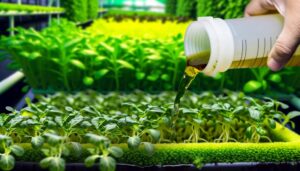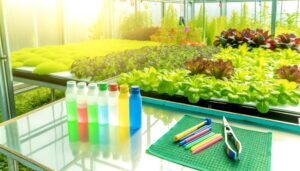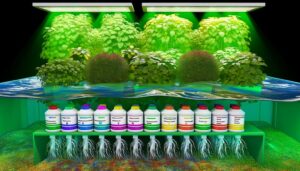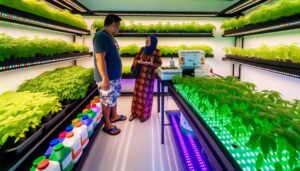Hydroponic Nutrient Chart for Vegetables
A hydroponic nutrient chart for vegetables provides essential guidelines on macronutrient and micronutrient ratios required at different growth stages for ideal plant health and yields. Seedlings benefit from a balanced, mild nutrient solution with an EC of 0.8-1.2 mS/cm and pH 5.5-6.0, emphasizing nitrogen and phosphorus.
During vegetative growth, nitrogen levels should be elevated to 150-200 ppm with an EC of 1.5-2.5 mS/cm and a pH range of 5.5-6.5. Flowering and fruiting stages necessitate increased phosphorus and potassium.
Regularly monitoring and adjusting nutrient solutions facilitate robust plant development and peak productivity. Discover additional insights into enhancing nutrient management.
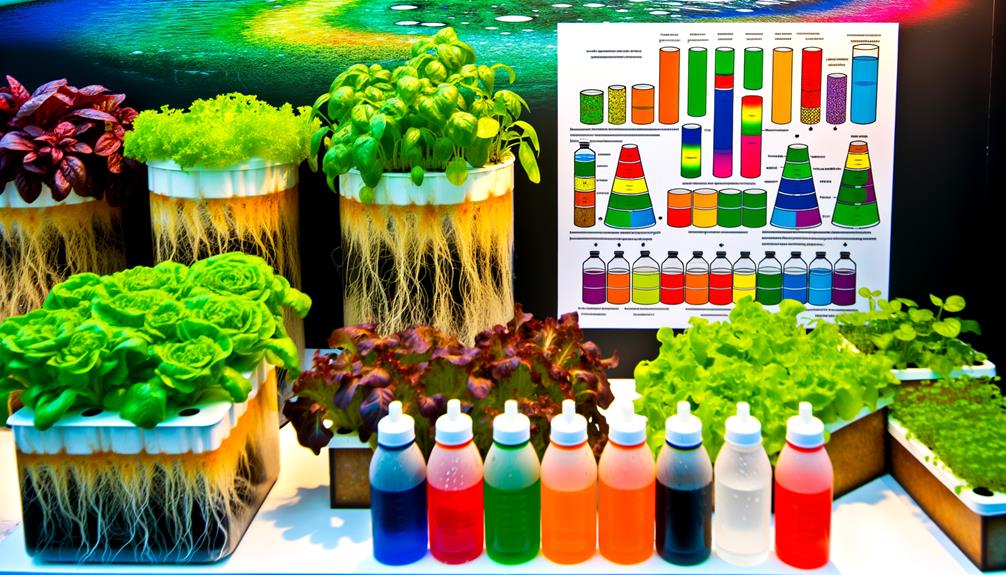
Key Takeaways
- Seedlings require a balanced, mild nutrient solution with EC 0.8-1.2 mS/cm and pH 5.5-6.0.
- Vegetative stage needs high nitrogen (150-200 ppm) and moderate phosphorus (50-70 ppm) and potassium (150-200 ppm).
- Flowering and fruiting stages require increased phosphorus and potassium for energy transfer and fruit quality.
- Common nutrient deficiencies include nitrogen (chlorosis), phosphorus (stunted growth, purple leaves), and potassium (scorched leaf edges).
Essential Nutrients
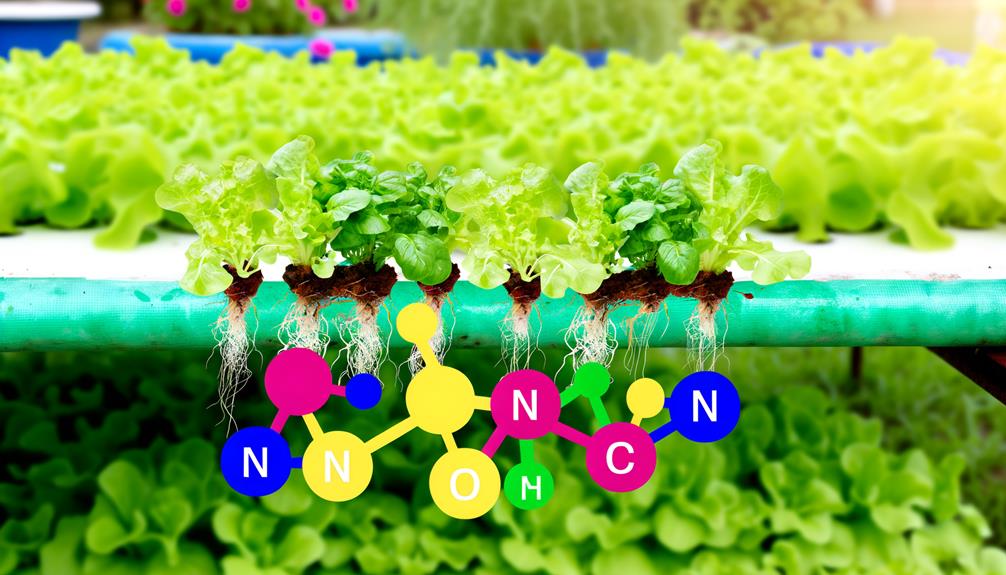
A thorough understanding of essential nutrients is imperative for maximizing the growth and yield of hydroponic vegetables.
Key macronutrients—nitrogen (N), phosphorus (P), and potassium (K)—play significant roles in plant development. Nitrogen supports vegetative growth, phosphorus is essential for root and flower development, and potassium enhances overall plant health and disease resistance.
In addition to these, secondary nutrients such as calcium (Ca), magnesium (Mg), and sulfur (S) are fundamental for specific physiological functions.
Micronutrients, including iron (Fe), manganese (Mn), zinc (Zn), copper (Cu), boron (B), and molybdenum (Mo), though required in smaller quantities, are critical for enzymatic activities and metabolic processes.
Precision in nutrient management guarantees robust plant health, ideal yields, and superior vegetable quality.
Seedling Stage Requirements
Understanding the precise nutrient requirements during the seedling stage is vital for establishing a strong foundation for hydroponic vegetable growth.
During this phase, seedlings require a balanced yet mild nutrient solution to guarantee robust root development and healthy initial growth.
Key elements include:
- Nitrogen (N): Essential for early leaf and stem development.
- Phosphorus (P): Important for root growth and energy transfer.
Maintaining an Electrical Conductivity (EC) of 0.8–1.2 mS/cm and a pH range of 5.5–6.0 is recommended to optimize nutrient uptake.
Regular monitoring and adjustments based on real-time data can prevent nutrient imbalances, thereby promoting a healthy start for your hydroponic vegetables.
Vegetative Growth Needs
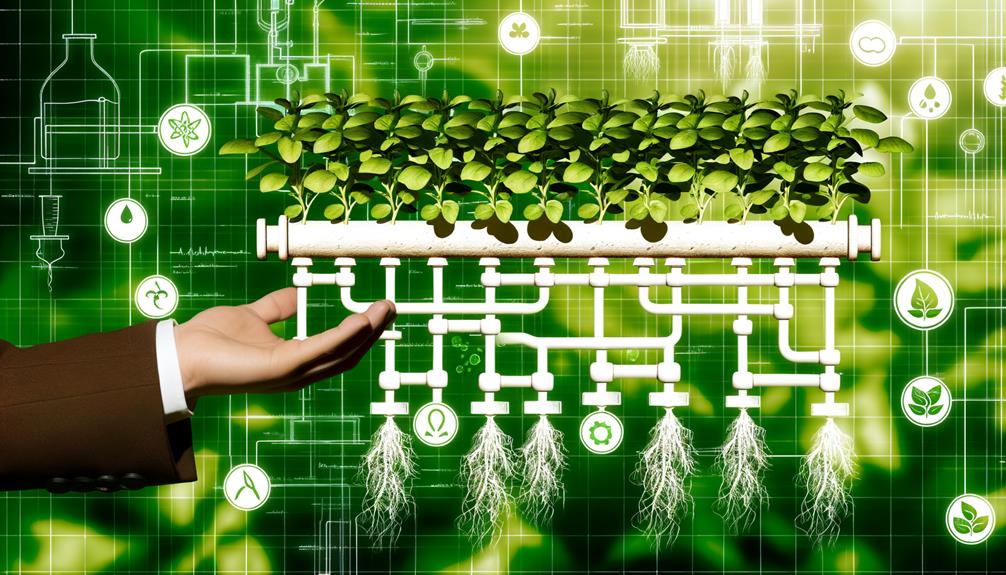
During the vegetative growth phase, hydroponic vegetables require increased levels of nitrogen to support rapid leaf and stem development. Nitrogen is critical for chlorophyll formation, directly influencing photosynthetic efficiency and biomass accumulation. Preferred nutrient solutions should contain nitrogen levels between 150-200 ppm.
Additionally, phosphorus and potassium should be maintained at 50-70 ppm and 150-200 ppm, respectively, to guarantee robust root systems and overall plant vigor. Monitoring electrical conductivity (EC) is essential, with ideal EC values ranging from 1.5 to 2.5 mS/cm.
Regularly adjust pH levels to stay within the 5.5-6.5 range for nutrient uptake efficiency. Accurate nutrient management during this phase facilitates healthy growth, setting the foundation for subsequent developmental stages.
Flowering and Fruiting Nutrients
Flowering and fruiting stages of hydroponic vegetable cultivation demand a recalibrated nutrient profile, with an increased emphasis on phosphorus and potassium to support reproductive growth and fruit development.
During these stages, nutrient formulations should adjust to guarantee peak yield and quality. Phosphorus is critical for root development and energy transfer, while potassium enhances fruit size and overall plant vigor.
- Phosphorus (P): Essential for energy transfer and root development.
- Potassium (K): Enhances fruit size, quality, and overall plant health.
A balanced nutrient solution tailored for flowering and fruiting will greatly influence the productivity and health of hydroponically grown vegetables, guaranteeing robust growth and bountiful harvests. Ensuring the hydroponic nutrient solution contains optimal levels of essential macronutrients like nitrogen, phosphorus, and potassium will support strong root development and abundant yields. Additionally, micronutrients such as calcium, magnesium, and iron play a crucial role in preventing deficiencies and promoting overall plant vitality. Regular monitoring and adjustment of the hydroponic nutrient solution help maintain ideal growing conditions, resulting in healthier plants and more consistent harvests.
Common Nutrient Deficiencies
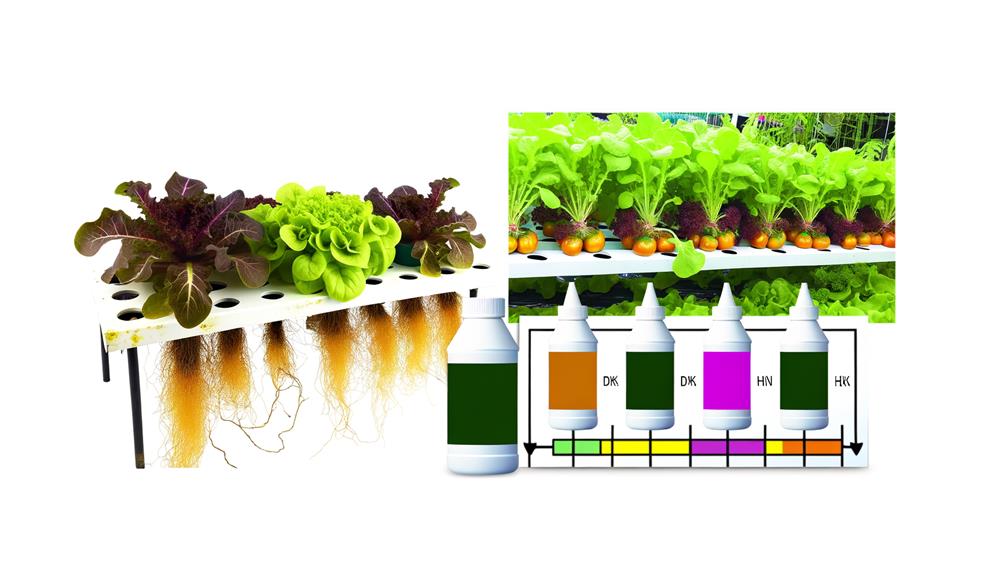
Identifying common nutrient deficiencies in hydroponic vegetable cultivation is essential for maintaining ideal plant health and ensuring maximum yield.
Among the most prevalent deficiencies are nitrogen, phosphorus, and potassium.
Nitrogen deficiency typically manifests as chlorosis, particularly in older leaves, indicating its role in chlorophyll production.
Phosphorus deficiency is often evidenced by stunted growth and purplish coloration in leaves, highlighting its critical function in energy transfer and root development.
Potassium deficiency can be identified by scorched leaf edges and interveinal chlorosis, reflecting its importance in enzyme activation and osmoregulation.
Regularly monitoring nutrient solutions and adjusting based on precise measurements, such as Electrical Conductivity (EC) and pH levels, can preemptively address these deficiencies, promoting robust plant growth and peak productivity.
Conclusion
In summary, the hydroponic cultivation of vegetables necessitates a precise balance of essential nutrients tailored to each growth stage: seedling, vegetative, and flowering/fruiting.
Addressing common nutrient deficiencies proactively guarantees peak plant health and yield.
A well-maintained nutrient regimen can make the difference between thriving crops and those that barely scrape by.
Mastery of these principles will enhance efficiency and productivity in hydroponic systems, ultimately leading to bountiful harvests.

